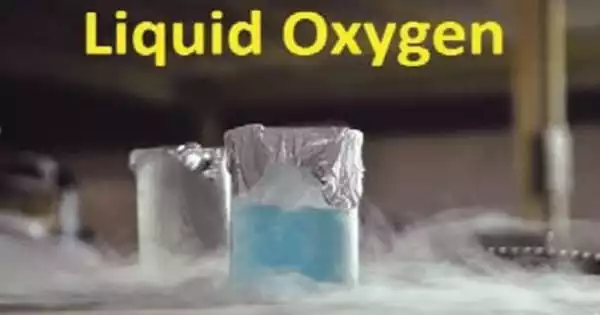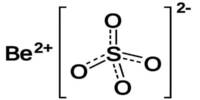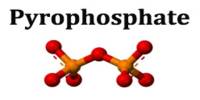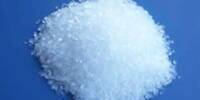In the aerospace, submarine, and gas sectors, liquid oxygen, or Lox, is the liquid version of molecular oxygen. It was employed as an oxidizer in the first liquid-fueled rocket built by Robert H. Goddard in 1926, and it is being used today.
Liquid oxygen is a cryogenic liquid with a pale blue color. Cryogenic liquids are liquefied gases with normal boiling points of less than -238 degrees Fahrenheit (-150 degrees Celsius).
Physical properties
Liquid oxygen is a pale blue liquid that is highly paramagnetic, meaning it can be hung between the poles of a powerful horseshoe magnet. Liquid oxygen has a density of 1.141 kg/L (1.141 g/ml), which is somewhat higher than liquid water, and it is cryogenic, with a freezing point of 54.36 K (−218.79 °C; −361.82 °F) and a boiling point of 90.19 K (−182.96 °C; −297.33 °F) at 1 bar. Because liquid oxygen has an expansion ratio of 1:861 under 1 standard atmosphere (100 kPa) at 20 °C (68 °F), it is employed as a transportable supply of breathing oxygen in some commercial and military aircraft.
Liquid oxygen, due to its cryogenic nature, can cause the materials it comes into contact with to become exceedingly brittle. Liquid oxygen is also a highly effective oxidizing agent: organic compounds burn quickly and energetically in liquid oxygen. Furthermore, when soaked in liquid oxygen, various materials, such as coal briquettes, carbon black, and others, might detonate unexpectedly in the presence of ignition sources such as flames, sparks, or impact from mild strikes. This is a common occurrence in petrochemicals, including asphalt.
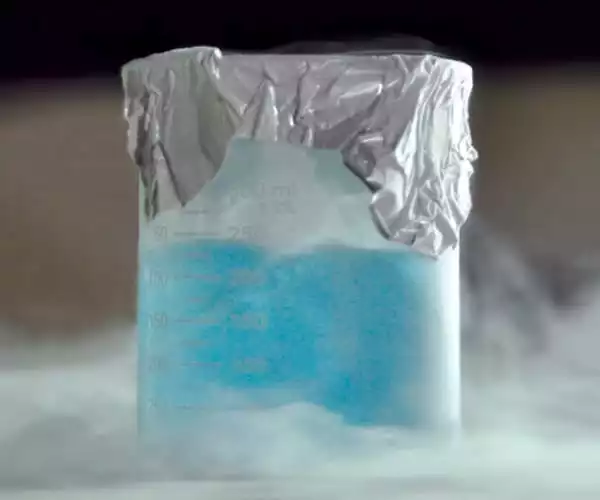
Gilbert N. Lewis postulated the tetraoxygen molecule (O4) in 1924 as a possible explanation for why liquid oxygen violated Curie’s law. Although there are no stable O4 molecules in liquid oxygen, modern computer models show that O2 molecules seek to combine in pairs with antiparallel spins, generating temporary O4 units.
Liquid nitrogen has a lower boiling point than oxygen, at 196 °C (-77 K), and vessels containing liquid nitrogen can condense oxygen from air: when the majority of the nitrogen has evaporated from such a vessel, there is a risk that the remaining liquid oxygen will react violently with organic material. Liquid nitrogen or liquid air, on the other hand, can be oxygen-enriched by allowing it to stand in open air; atmospheric oxygen dissolves in it, whereas nitrogen evaporates preferentially.
Liquid oxygen has a surface tension of 13.2 dyn/cm at its standard pressure boiling point.
Uses
Liquid oxygen is classified as an industrial gas in commerce and is frequently employed in industry and medicine. In a cryogenic air separation facility, fractional distillation is used to produce liquid oxygen from the oxygen found naturally in air. It is utilized as an oxidant for liquid fuels in the propellant systems of missiles and rockets.
Liquid oxygen treatment is the medical process of supplying extra oxygen to a patient who cannot receive adequate oxygen on their own. Liquid oxygen treatment can be used to treat conditions such as asthma, cystic fibrosis, dysphasia, chronic obstructive pulmonary disease, heart failure, lung illness, and pneumonia.
Air forces have long recognized the strategic use of liquid oxygen, both as an oxidizer and a source of gaseous oxygen for breathing in hospitals and high-altitude aircraft flights. The USAF began a program in 1985 to establish its own oxygen-generation facilities at all large consumption locations.
